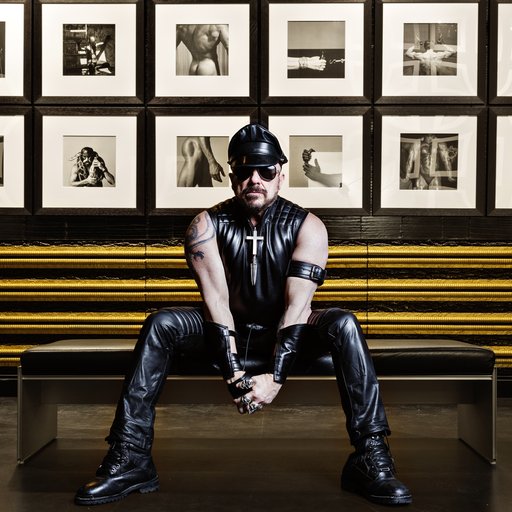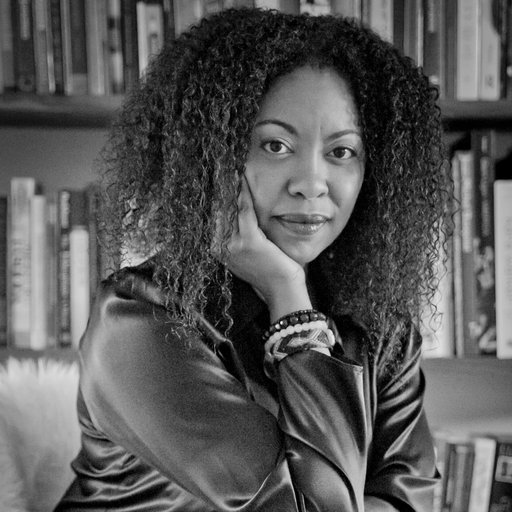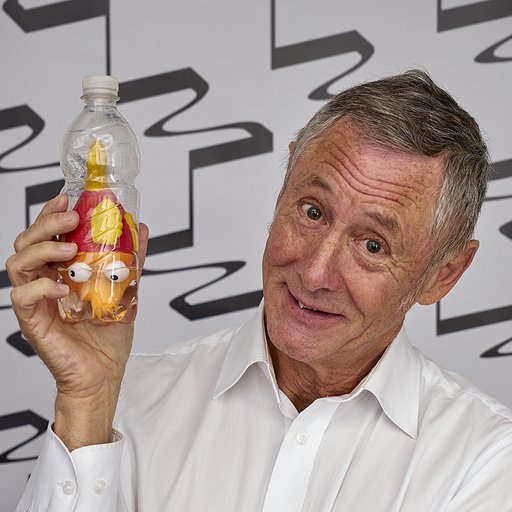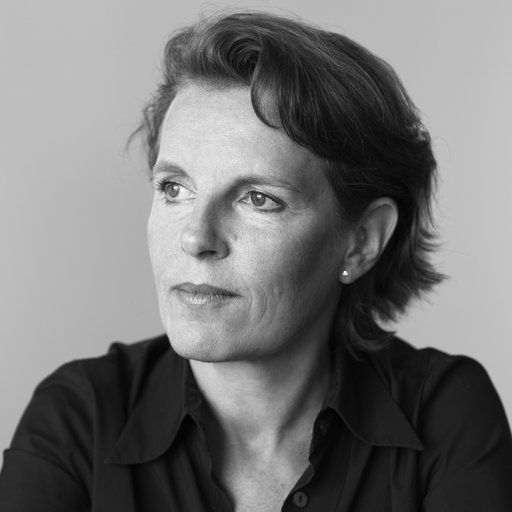Called “one of the most-sought-after architects on the planet” by the New York Times, Peter Marino is a legend in the world of elite consumption for his flawless residences, stunning art galleries, and, most of all, flagship stores for such fashion titans as Chanel, Louis Vuitton, and Dior. Always clad in his iconic biker uniform, Marino is also, first and foremost, a champion of art—from his early days working with Warhol to his extensive architectural collaborations with artists to, now, his own reinvention as an artist himself. In part two of our interview with the architect on the occasion of his new Phaidon monograph Peter Marino: Art Architecture, Andrew M. Goldstein spoke to Marino about the logic and process behind his trademark focus on incorporating art into commercial settings.
READ PART 1 OF THIS INTERVIEW
“Art Architect” Peter Marino on How He Became the Dark Prince of Luxury
You were talking about how you began working with clients like Gianni and Marella Agnelli and Yves Saint Laurent and Pierre Bergé. You grew up speaking several languages—did that help you connect with these luminaries?
I’ve found that in life in general, you use absolutely every part of your background every day. My favorite example is when I was interviewed by Giorgio Armani to build his house. Coming from Italian-American roots, I spoke Italian, and the whole interview was conducted in Italian. The other person he interviewed for the house was Richard Meier, who did not speak Italian. I got the job. I’ve always felt that you want to communicate with your architect, so you pick the one who speaks your language. I find that a lot now when we work in the Middle East, where people who speak Arabic, because language is culture.
I imagine Italian comes in handy when dealing with top fashion companies.
Yes. Then, a lot of my mom’s family had lived in France before they emigrated, and hence I also grew up speaking French. I find it no accident that I work for all the French luxury houses. Every drop of your background comes in handy.
As you began to get more major commissions, famously working with Barney’s to create their flagship store and then going on, over the years, to work with the world’s premier fashion houses, you always kept art at the center of your approach. It’s telling, now, that you have decided to have your first major monograph, Peter Marino: Art Architecture, focus on this dynamic. Why is it so important to you to fuse art with your architecture?
Well, I think it’s one of my strengths. I’ve had this really great career. Why? It’s like the famous Gypsy Rose Lee line—everybody’s got to have a gimmick. The very real value of what I bring to architecture is my fine-art background and my interest in fine arts, my involvement with artists, and, as you know, the way my career was launched with artists. For my first book, it seemed like my involvement with art was where I could put my best foot forward. And now, over the last three months, the press has started calling me the “art architect,” which is really interesting since it’s always been the case, but somehow making a book concretizes it with you chaps who are writing on the other side of the table.
Another way of looking at it is that every architect has produced 20 good buildings. That’s not quite true, but there are a lot of good architects with a lot of good work, so if you want to distinguish yourself in the world today to get somewhere you have to have a gimmick. My involvement with artists is why my projects are good, and why people like looking at them. I’ll tell you the funniest story. When you do private homes, you work on the design for a year, then you spend two years building it, and then six months on the install. The average private home takes three to three and a half years. And if you’ve done a really good job, when the new owners have their first guests over, the only thing the guests say is, “Oh, that Modigliani over the fireplace is the most beautiful thing I’ve ever seen.” So, that’s good.
This approach clearly makes you stand out to the major fashion companies, which have enormous coffers at their disposal and incredible brands to uphold, and could work with any architect in the world. But if they work with you, they don’t only get a building, they also get the added luster of the art. So, I wonder, what would you say the presence of art in one of these great flagship spaces lends to the project? What does art do for brands?
It provides a triple reflection. The art must be super high-quality because, number one, a good piece of fine art reflects the owner’s attitude toward the customer—it says, “We’re going to show you an incredible amount of respect.” It also reflects on the merchandise. A department store will put a poster up on the wall—what does that tell you about the quality of their goods? You think, “Posters. Crummy handbags.” If you’re in a store looking up at a giant Michal Rovner video of the incredible gas fields of Kazakhstan, you’re thinking, “I’m looking at something of quality. I’m not looking at crap here.” It communicates that the product is above and beyond what you might expect at a department store, or at medium-priced brand outlet. So, it puts everything in context.
Number two, the clients are always trying to get the costs down, and when they tell me I’m the biggest part to their budget I do believe it. The architecture that the brands commission is the single largest item in their budget annually. So if you take a billion-dollar budget, with several hundred million committed to 12 stores around the world or whatever it is in real estate, I know that I’ve got to compete with the second-largest item in their budget, which is always advertising.
What I always say is that my architecture is a brand advertisement, because if only one out of every four people who go into a luxury store purchases something, the goal is that the three people who aren’t purchasing have a really worthwhile experience and leave with a positive attitude toward the brand. It’s like if you see an ad in Vogue you might think, “Oh, that looks kind of chic.” It’s the same thing if you see Jean-Michel Othoniel’s Beads at Chanel in London, where it’s a 60-foot-high pearl necklace. You can’t put a dollar value on that. So, the brand enhancement is the other reason why I do it.
Number three, the strongest one, is that it reflects on me as the architect—I just like looking at beautiful things.
Art for art’s sake.
Well, yeah. I’m a big believer in beauty.
How about merchandizing? You’re known to be very attentive in your architecture to the brands’ bottom line, incorporating elements that help move the visitor toward a purchase—so that if you walk in, you walk out with something in your hand. I wonder, what role does the art play in this process?
Does art make you buy something? Not unless you do what we just did at Dior, where Marc Quinn literally designed the handbags and they sold like hotcakes at £4,500 each. Sometimes, artists have direct involvement. At the same time, he did a painting commission for me that I stuck on the wall, and, honestly, that’s just because of my interest in beauty—as you said, art for art’s sake. But in terms of brand enhancement, it shows a very real respect for the customer. It says to them, “Look, we respect you enough to do this.” And it’s not unnoticed—we get fan letters from people all the time saying, “God, I love the finishes,” or, “Hi, I’m from Oklahoma and I love that gold wall you did—can you tell me where you got it?” I was like, “Well, I didn’t get it anywhere, but ok…. Nancy Lorenz is an artist, and she painted that lacquer.”
That’s a very important distinction, because you don’t just buy the artworks in your stores from auctions or gallery shows—you almost exclusively commission them directly from the artist. That’s one of the revelations of your new book.
That’s why we made this book. When my editor, Emilia Terragni, began looking at all my work she said, “My God, I didn’t really realize the extent of the art that you commission. This message has to be made clear, because nobody else is doing this.” It always helps having an outside voice telling yourself something about yourself, because I hadn’t really thought about it myself. Sometimes observations coming from someone else are valuable. I’m doing 81 projects a year. Do you think I have time to self-analyze? I don’t. When am I supposed to do that? When I’m riding my motorcycle? I’m trying to not die. [Laughs]
The upshot is that not only do you have a relationship with the client on a specific project, you also have a relationship with the artist or artists that you commission. So, how do you choose the artists? You have worked with such a broad range.
It’s usually if I see a show at a museum or a gallery and get a visceral feeling that this artist might be great for this brand. For instance, with Othoniel, I saw all these beads. Chanel’s primary symbol was pearls—she had strings and strings and strings of pearls around her neck. So I said to him, “Would you ever consider doing a commission for Chanel based on a string of pearls,” and he made a white necklace, and it was a killer. And it was very, very successful, and since then he’s done about 10 of them for us. So, I love to pick somebody who has something in their oeuvre that works for the brand. You don’t want to ever take a square peg and say, “I’ve got this round hole, want to try and fit in?” That’s obviously not going to work. You try to pick somebody who might be sympathetic.
With someone like Othoniel, who makes monumental sculptures, the art must become part of the architectural design. How does that work?
Othoniel’s beads in Chanel London took a huge engineering feat. First of all, the weight of 60 feet of glass beads was thousands of pounds, so you have to accommodate it structurally—you can’t add this afterwords. [Laughs] You have to put in I-beams, and a steel substructure had to be ordered from Germany. Some of these projects are massive. Richard Deacon’s beautiful flying wood sculpture in Louis Vuitton Singapore had to be factored into the load-bearing capacity of the roof. I mean, you can’t just casually say, “Oh, I think I’ll just glue a 12-ton sculpture to my ceiling” after you build the space.
At what stage in the process of building a site do you choose the art?
Well, ideally at the very beginning, but it’s never the case. It’s different every time. I wish I could be so organized as to tell you, “Oh, it’s when the project’s at 10 percent.” But, first of all, you don’t always get the inspiration. Second of all, sometimes you bark up the wrong tree, and you lose a little bit of time. Third, one of the most difficult things about working with successful artists today is they are also plenty busy. Somebody like Michal Rovner may have an exhibition this summer at the Louvre… and at the Tel Aviv museum, and in Stuttgart, and at another museum. That’s where they’re going to put their life’s blood—that’s their legacy, and you have to respect them for that.
So the timing of a lot of these projects is one to two years in advance because they’re so booked. They’re like Broadway stars with their museum schedules. You’ve got to say, “Ok, Michal, but if you do this thing for me in Hong Kong, 60 million people are going to see it. I’m your fairy godfather.” [Laughs] Then you can get their attention. But what I’m saying is that you’ve got to give artists a lot of time, and since we’re building buildings it’s okay, we can do that.
What percentage of your average overall budget would you say goes toward art?
Every site is different, and it depends on the location. Brands who are doing higher volume of sales will commit to a much higher budget for art. If you’re doing a very small city with sales that are very, very tiny, you’re probably not going to get a commission of an art project. But I’d say on average it’s about three percent, but I’m really pulling a rabbit out of a hat.
Considering all of your buildings, all that you’ve done in the luxury arena, and all of your engagement with the art of your time, your career has been unusually rich and wide-ranging. If you could decide your legacy, what would you want it to be?
I’d like to think that my architecture really expressed the times in which we lived, or helped define the time in which we lived. Because, for me, that’s one of the definitions of great art. Warhol’s 1960s Pop art paintings so nailed America and its values with Heinz ketchup and Campbell's soup—we are not a land of Titian paintings, we are a land of mass-production and a land of Pop celebrity. Witness the Kardashians—he saw that in Marilyn and Liz.
So, I try so hard in the stores I do, in the homes I do, to make it so that if you took this compendium of my work, it would express the time in which we live. That’s my real goal, because why do we still admire Dutch paintings? Not because they realistically painted a pear—anyone can do that today. But today what we prize about the still lifes is that they nailed the Burgermeister values of Dutch society in 1612 like nobody’s business. That’s what I try to do, and I hope my work will be looked at this closely and will be part of the legacy: “Yes, this fellow lived in 2020, and his work is part of the fabric.”
Right now I’m very, very excited that we were just asked by the government of Dubai to make a proposal for a pavilion for Expo 2020 in Dubai. If you get to do something like that, you’re part of this forming of a fabric of an aesthetic statement of the time in which you live. I’m going to throw my heart and soul into that one. Let’s hope I get it.
READ PART 1 OF THIS INTERVIEW
“Art Architect” Peter Marino On How He Became The Dark Prince Of Luxury



























